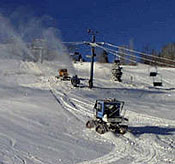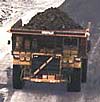By Bob Kelleher and Amy Radil
December 6, 1999
THE IRON RANGE RESOURCES AND REHABILITATION BOARD
was formed as a state
department nearly 60 years ago, to help prepare Minnesota for the decline
of its iron-mining industry, and to revitalize the state's forested and
mining regions.
Media reports savaged the IRRRB's business and tourism investments in the 1980s. Infighting among board members and the agency's commissioner
led one political leader to declare the IRRRB "dysfunctional." Now, the IRRRB enters a new era, with a revamped board of advisors and a new
commissioner appointed by Reform Party Governor Jesse Ventura.
|
|
Part One: The History |
|
|
|
||
| Related Links: | ||
|
Blandin Foundation Center for Economic Development Bureau of Business and Economic Research Giants Ridge Ski Area Iron Range Resources and Rehabilitation Boad Iron Range Economic Alliance NRRI Business Group Itasca Development Corporation City of Silver Bay City Hall Ely Area Development Association Minnesota Power Minnesota Technology, Inc. About the Reporters Bob Kelleher began with Minnesota Public Radio as a part-time reporter in 1990 while completing work on a business degree. Kelleher became a fulltime reporter and was appointed bureau chief in 1993. Before his tenure with MPR, Kelleher abandoned a radio disc-jockey career to assume management of a small-market radio-news operation in Boone, Iowa. He also reported news for a commercial station in Duluth. Amy Radil joined MPR as a reporter in the Duluth bureau in 1997, where she covers everything from moose calling to charter schools. She grew up in Omaha, Nebraska and attended Williams College in Williamstown, Massachusetts. For two years Radil worked as a reporter in Washington, D.C. covering medical issues for FDC Reports. She received her master's degree in journalism from Columbia University and pursued her true vocation, radio. |



